In the ever-evolving recruitment landscape, 2024 marks a turning point as companies increasingly pivot away from conventional resume-centric hiring practices. The new focus is on a skills-based approach, signaling numerous advantages for both employers and job seekers. As your organization prepares for the next wave of talent acquisition, consider these actionable tips to integrate and excel seamlessly in skills-based hiring.
Clearly Identify the Skills You Need for Each Role
Gone are the days of generic job descriptions. The first step toward effective skills-based hiring is examining each open position. Scrutinize the hard and soft skills imperative for success, ensuring they align with the contemporary demands of the role. Precision is key; hone in on skills that are not only relevant but directly applicable to the position at hand. Utilize tools such as skill matrices to create a comprehensive overview of the skill landscape required, ensuring that your hiring strategy is finely tuned to your organization’s specific needs.
Use Structured Interviews to Assess Candidates’ Skills
A structured interview approach is pivotal in unraveling a candidate’s true capabilities. Craft questions that delve into their past experiences, prompting them to articulate how they have applied their skills in real-world scenarios. Incorporate behavioral questions to gauge problem-solving abilities and situational inquiries to assess adaptability. For a tangible gauge of hard skills, integrate skill tests or exercises into the interview process, offering actual evidence of their proficiency.
Emphasize Soft Skills
While hard skills are quantifiable, soft skills like communication, collaboration, and problem-solving should not be understated. Dive into candidates’ past experiences and use situational interview questions to uncover evidence of these critical attributes. Given the challenge of measuring soft skills, allow candidates the opportunity to demonstrate them during the interview process.
Require a Skills-Based Resume
Shift the paradigm by requesting applicants to submit a skills-based resume. This document should spotlight relevant skills, accompanied by evidence and examples showcasing proficiency in each area. Diminish the prominence of unrelated work experience and educational credentials that do not directly align with the sought-after skills.
Use Skill Rubrics and Templates for Structured Evaluations
Introduce structure into your evaluation process by employing skill rubrics and templates. A systematic scoring system for diverse skill sets can standardize your assessment of candidates, streamlining the interview and hiring processes across the board.
Cast a Wider Net for More Diversity
One of the standout advantages of skills-based hiring is its potential to diversify your talent pool. By removing biases tied to previous job titles or educational backgrounds, this approach opens doors to candidates from non-traditional sources who might otherwise be overlooked. Casting a wider net ensures that you tap into a rich pool of diverse, skilled individuals.
Conclusion
Adopting a skills-based hiring strategy is not merely a trend but a strategic imperative to align your workforce with organizational goals in 2024. Candidates possessing the requisite skills are poised to be more productive from day one, with more potential for future impact. Through planning and execution, skills-based hiring stands not just as a necessity but as a competitive advantage for companies in the year ahead.
Written in conjunction with Joe Matalone – Executive Vice President, Chris Thrall – Director of Talent Solutions and Colin Harris – Business Development Lead.
With many companies starting to kick up their hiring initiatives again, they need to figure out the best hiring process for their company.
Since COVID-19 left many furloughed, the talent pool has grown substantially. Something that we haven’t seen in years. Below, we will discuss direct hire, contract-to-hire and temporary processes and the best situations in which to use them.
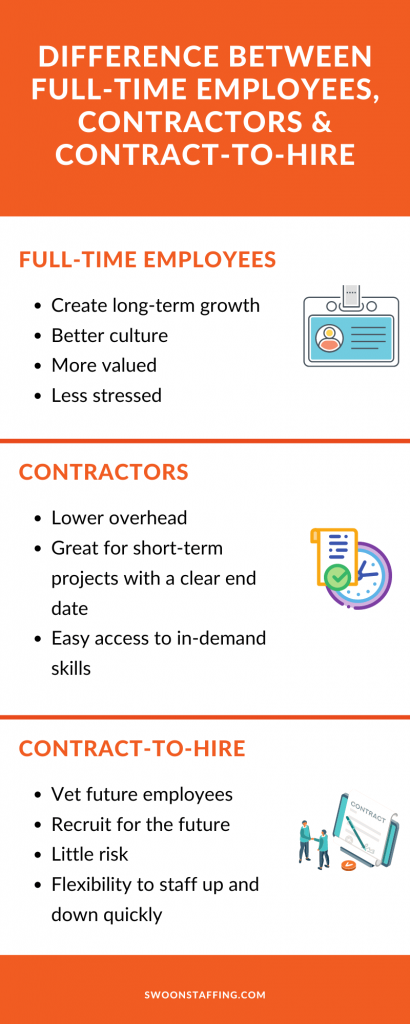
Recap of Definitions
Direct Hire Placement: A staffing agency adds permanent staff directly to another company’s payroll.
Temp Staffing: A candidate is hired as a solution for unpredictable workloads, project work, seasonal peaks and other short-term needs such as a leave of absence. They are employed by the staffing agency and all positions have an established timeframe.
Contract-to-Hire: The selected candidate begins their employment contract on the staffing agency’s payroll, not the client’s. They are placed in a short-term position for a set period, with the possibility of being hired as a full-time employee at the end of that contract.
Advantages
Direct Hire:
- The candidate is sourced as a full-time employee from day one. This allows you to avoid the annuity costs associated with contract/contract-to-hire employees and your new hires feel that they are part of the team right away.
- Direct hire roles are more attractive to passive candidates. Thus, allowing you to see a higher number of highly qualified candidates.
- This is evident because you can offer better perks and benefits packages to attract the type of prospective candidates you are looking for.
- Typically, there is stronger employee commitment. These employees often have a better sense of stability and security within the company that they are placed in.
Contract/Temp Employees:
- Saves your company time and money. These employees allow you to get the help that your company needs quickly without the cost and effort of recruiting and hiring full-time staff members.
- Offers flexibility by helping companies fill openings quickly that are caused by seasonal demand or employee absence. This way, companies can meet demands while not overstaffing or requiring current team members to take on more tasks.
- You can tap into skills that you currently don’t have inhouse. This way, you can quickly complete projects that your current team members don’t have the skills or experience.
Contract-to-Hire:
- The ability to experience a trial run. You can “try before you buy” and minimize the risk of an employee not being a fit long-term.
- There is more budget flexibility.
- These positions can give a company the time to work a new full-time employee into the budget while still getting the work done.
- Contract-to-hire employees are typically not eligible for benefits until they become a full-time employee. However, in most cases, they get the option of receiving benefits through the staffing agency they are working with.
- The employees are typically only paid on an hourly basis for the specific hours worked rather than a fixed salary.
- You can save on specialized skills that you don’t already have in-house. Contractors can help you complete projects that require skills and experience that your full-time staff doesn’t already have.
- Contract-to-hire can help you accommodate growth. We can’t always predict when growth or expansion needs to happen, and this can be extremely difficult for your full-time employees to take on additional work themselves when they have a full workload already. During these times, you can leverage contract staffing to complete the necessary extra work.
How Does Contract-to-Hire Work?
When you use a staffing agency to fill contract-to-hire positions, they will handle many of the front-end recruiting tasks, such as:
- Sourcing candidates
- Reviewing resumes
- Conducting initial screenings
Once a candidate has moved through these stages, they will be passed along to the client for final interviews. The company will then make the final decision with insights and guidance from the staffing agency if needed. Once a candidate is selected and accepts an offer, they will begin their employment contract on the staffing agency’s payroll rather than the client’s.
The duration of these contract-to-hire positions varies from one month to being indefinite. However, they will usually run from three to twelve months. In most situations, the client will have the opportunity to convert the contractor to a full-time hire in a manner that meets their needs.
Why Would a Company Dismiss the Idea of Hiring a Contractor?
When it comes to a company dismissing the idea of hiring a contractor, a few things come to mind.
- Contractors can be more expensive than hiring a full-time employee, depending on the situation.
- It’s more cost-effective to pay for a full-time employee than a contractor if you are going to keep them on for 2-3 years in some cases.
- Operating expenses (OPEX) are the cost of doing business, such as employee wages, utilities, insurance, and rent required for the day-to-day functioning of a company (including employee wages). In contrast, a capital expense (CAPEX) is an expense that a business incurs to create a benefit in the future (such as an IT project to upgrade a system that could require contractors to come in and complete that project). OPEX and CAPEX are treated quite differently for accounting and tax purposes and could be the reason for hiring one over the other.
- Companies don’t want to lose intellectual property. However, as a company hiring a contractor, you can have a written agreement executed before the commencement of the employment relationship. This agreement can assign to the company any and all intellectual property created by the employee during their employment with the company.
- Companies don’t have a history of hiring contractors and are unaware of the process – this is where we can come into play and help you understand the best path for your needs.
- Companies have budgetary challenges and might not be able to afford the contractor fees on top of the full-time employee fees if they choose to hire after the contract is up.
- Employees miss out on getting proper integration into the company culture.
- A company is challenged to bring in revenue, thus putting projects on hold that they could bring in a contract-to-hire to complete.
Why is Direct Hire Skyrocketing During COVID-19 and Not Contract-to-Hire?
At the beginning of this recession, we thought that we would see an increase in contract-to-hire over direct hire placements. When asked, Joe Matalone – EVP, had a great response to why he believes that direct hire placements are skyrocketing now.
“I think we can find our answers here in analyzing the U.S. stock market and employment data at the beginning, middle and present times of COVID-19.
Beginning of COVID-19: What we saw in the very early days of COVID was simply confusion at all levels as it came at us so quickly – which frankly jolted the global markets. Millions were furloughed during the pandemic, with a record 20.5 million U.S. jobs lost in April. However, some companies were and still are hiring thousands of new employees to keep up with shifting consumer demands and spending habits. That being said, some employers may have cut too deeply (particularly in the departments of Talent Acquisition) and have now realized that they need to hire again and hire quickly to maintain any competitive edge. Suddenly, there is a fresh wave of talent that the employers have not seen in many years due to the historical run of strong overall employment numbers.
Present Day: Fast forward to the present; it feels like the market is tightening again in specific skillsets, most notably in digital and technology, which were more resilient to the downturn. It’s almost as if we’re not in a recession any longer.
Final Thoughts: I think this will be the fastest end to a recession ever! Some areas of the market will take longer to recover, such as travel/retail/hospitality. Some employees that had been placed on leave, laid off, or maybe not treated so nicely during the last few months are looking and have options. You add in the embracement and acceleration of hiring remote workers now, and the talent pool gets very large.
During economic downturns, candidates are unwilling to leave their current “permanent” position for anything but a direct-hire position. When the country is in the middle (or hopefully tail end) of a pandemic, benefits such as health insurance are top-of-mind for everyone.”
Joe Matalone – EVP at Swoon
Conclusion
It’s important that you take a look at what is best for your company at that time. What works for one company might not necessarily work for yours. Will your company benefit more from having a direct-hire placement for a full-time employee, a temporary contractor or a contract-to-hire so that you may “try before you buy”? There is no right or wrong answer. It all just comes down to what you think will be the best, and if you have any questions along the way, we are always here to help!
Grab your drink of choice, cuddle up next to your pet and get ready for your next happy hour!
Right now, since everyone is in sort of a long-distance relationship, virtual happy hours are more important than ever to keep up with social interaction, have some laughs and figure out different ways to connect with each other.
There are many ways that we’ve found to keep our employees engaged and feel involved while working remote and we want to share those with you!
Have Fun!
One way that we’ve found to keep these virtual happy hours fun and really learn more about each other is to incorporate remote team building! Not only does this allow your employees to know each other, but they are also a great stress-reliever.
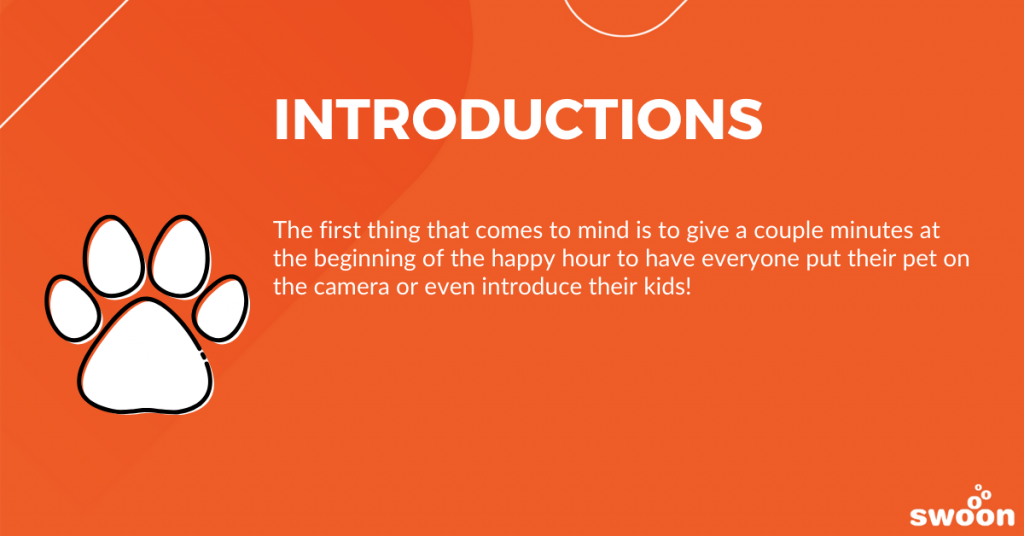
Introducing Pets/Kids!
Coworkers hear stories about everyone’s kids or pets either when they were in the office or over chat. Give them the opportunity to meet them on camera.
Play Some Icebreaker Games
Okay, we know what you’re thinking, “…but these are so cheesy!” Yes, we know they’re cheesy, but they’re also amazing at allowing your employees to talk and get to know each other better. Being remote can get extremely lonely and you want to offer time for employees to unwind. Here are some of our favorites!
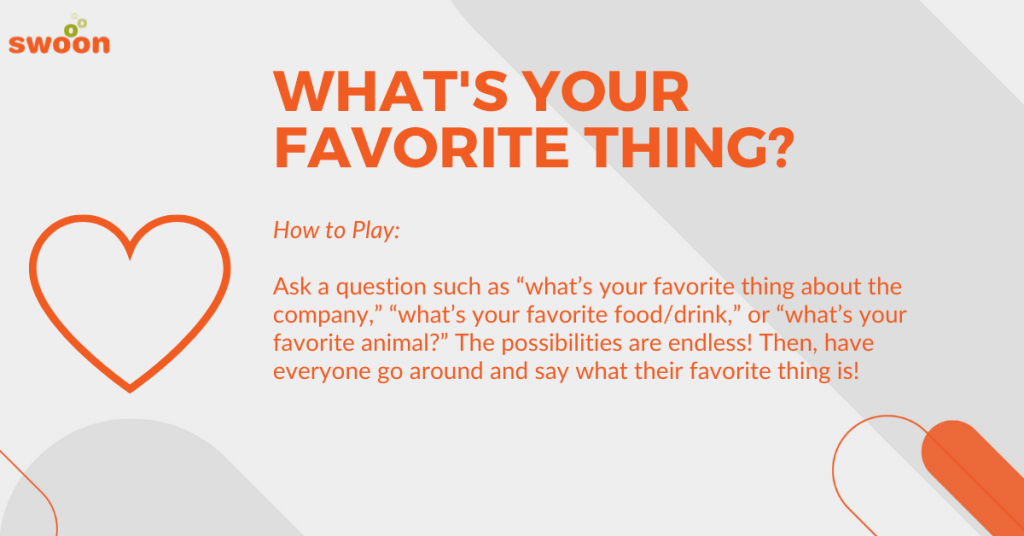
1. What’s Your Favorite Thing?
This is a great game to play when you aren’t sure how people will respond to playing an icebreaker game during a happy hour.
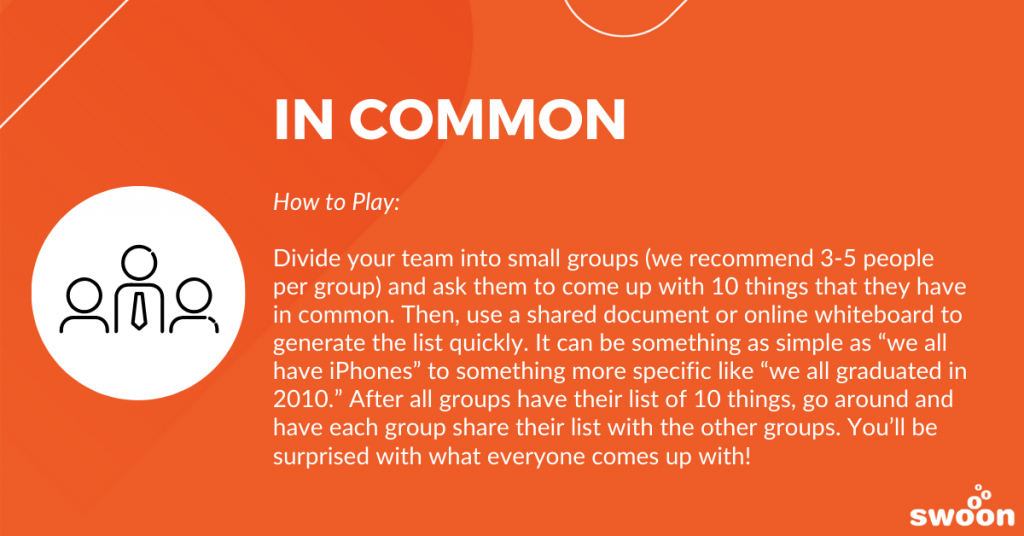
2. In Common
Is your team having trouble coming up with new ideas or communicating effectively while being remote? This could be your solution! This game allows your employees to get back on track and work as a team to achieve the end goal in a non-stressful environment!
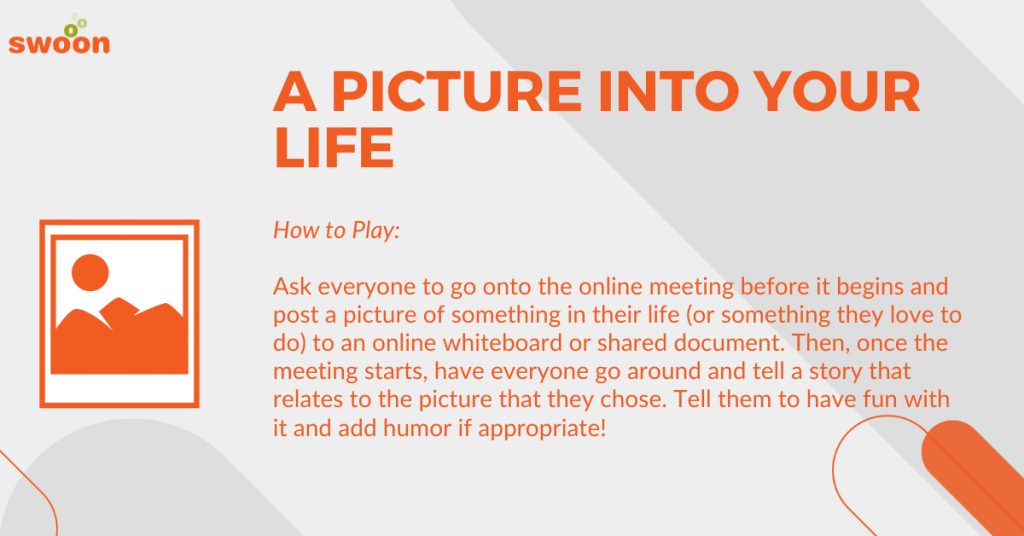
3. A Picture into Your Life
This game will allow your team to have fun and put their creativity to the test!
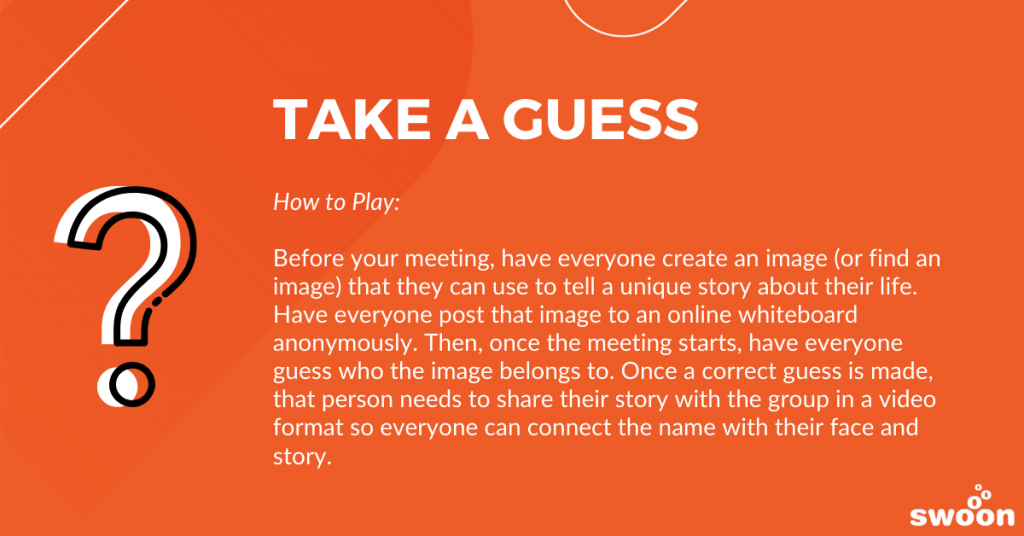
4. Take A Guess
Here is another game that allows your employees to utilize their creativity skills and learn about their coworkers in a fun way!
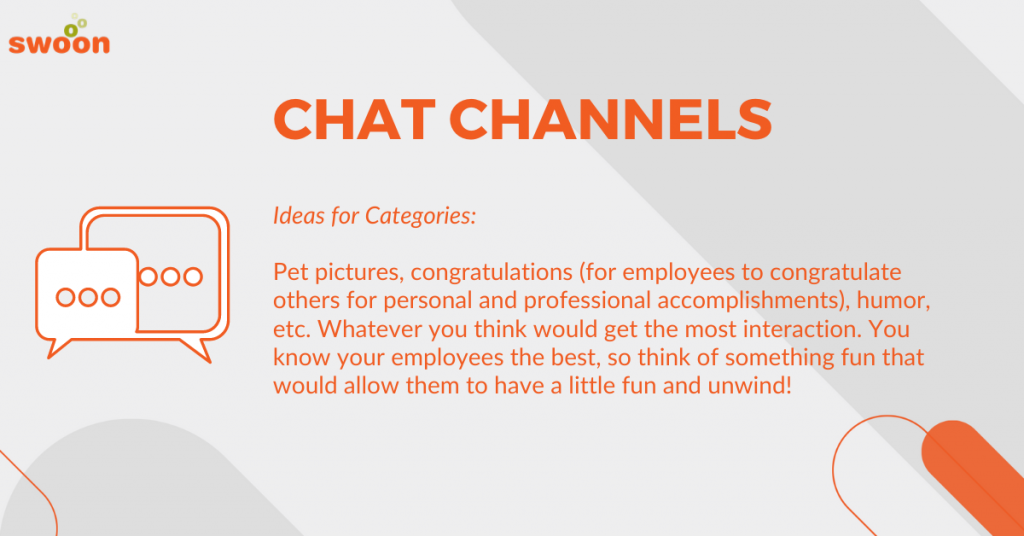
5. Chat Channels
Create fun, dedicated chat channels and announce them during your virtual happy hour. Do you know that your employees won’t respond well to a team building exercise? This could be the way that you get your employees to connect in a remote environment!

Keep It Simple!
You don’t need to always do something outside the box. Sometimes, the best way to get your employees to feel included is to just set up a time and space for them to talk and see one another. Having them add in their drink of choice allows the environment to feel a little more comfortable and laid back.
Need Help?
We would love to help you and your team navigate this new work from home environment! No matter if that’s through finding the best virtual happy hour solution or just the best work from home solution for you and your team. We’ve been doing this for a little over a year, so we would love to provide you with our insight! Feel free to send us a message!

